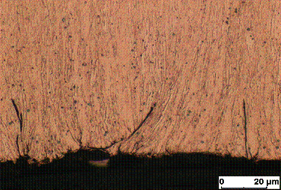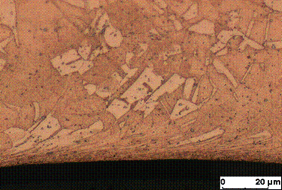Welding contact tips are highly misunderstood components in a MIG gun setup. Choosing the correct contact tip for your welding application and understanding how to keep it performing at its best are just as critical as anything else needed to produce a quality weld.
Using a contact tip that is too big or too small can create problems such as microarcing, overheating, friction, and wire jamming—all of which can lead to wire burnback.
How Contact Tips Impact Welding Operation Costs
Contact tips are one of the most frequently replaced components of a MIG gun. The contact tip is responsible for guiding the wire and transferring the current from the conductor tube—sometimes referred to as a swan neck or goose neck—through the filler wire and ultimately to the workpiece. It's critical functions include current transfer and wire targeting.
As one of the most replaced items in a MIG gun, it also tends to be one of the most costly MIG gun parts per year. Consider a contact tip takes about 10 minutes to change. If your welder is paid $30/hour and having to change a contact tip five times a day while you run 2 shifts, you're losing more than $13,000 a year in labor at that welding station by changing a contact tip more often that you need to, and that's before even factoring the cost of the contact tip.
Just being able to go from five contact tip changes a day to two changes would result in a savings of over $7,500 a year at a single welding station. And a great deal of that cost can be realized by simply using a contact tip material that matches your welding parameters and process that is of reputable quality. Sticking with quality welding contact tips ensure you get more life and spend less on your contact tips over the long haul.
While typically you want to trust your OEM's welding contact tips, retrofit contact tips from reputable welding equipment manufacturers can also prove to be cost-saving options for you when it comes to lessening the frequency of replacing contact tips if your OEM isn't getting you the results you need.
Contact Tip Size Matters
Contact tip size determines what wire size you can use and the amount of filler material that will be distributed during welding. When a contact tip begins to wear, the through-hole elongates and loses electrical conductivity, which greatly affects the gun’s ability to transfer current to the welding wire. Additionally, the tool center point (TCP) begins to fluctuate as the wire dances around inside the now oversized tip. These conditions lead to poor arc starts, lower penetration, and decreased weld quality.
Sizes for welding contact tips range from .024" to .094" in terms of a wire size it can guide. Generally speaking, the larger the wire, the higher the parameters and the faster the deposition rate. It's highly recommended that to match the contact tip size to the wire size with your MIG gun.
Likewise, contact tip threads come in a range of sizes from M6 to M12. These sizes are entirely dependent of the contact tip holder size, but the thread sizes correlate directly to the rating of the MIG gun. You won't see a 500-amp MIG gun, for instance, using an M6 contact tip. Similarly, you won't see a 200-amp MIG gun using an M10 contact tip because it's unnecessary.
Choosing the correct contact tip for your welding application and understanding how to keep it performing at its best are just as critical as choosing all the other components and parameters needed to produce a quality weld.
Common Welding Contact Tip Types
Four types of contact tip types are most commonly used in welding applications (as well as one for laser welding), and each has its pros and cons:
#1: Standard Copper Welding Contact Tip (E-Cu)
A standard copper welding contact tip has a relatively high current transfer rate at greater than 55 S/m* electrical conductivity, and it is used mostly in hand-held welding applications.
Although standard copper offers the highest conductivity of all of the standard alloys, it is more susceptible to mechanical wear than other materials. As a raw mineral, copper naturally is relatively soft, which means it makes current transfer easier, but it also means the material has a lower melting point. As the temperature rises in an E-Cu tip, it becomes softer than the wire that is being fed through it. As the copper softens, the wire wears and deforms the internal diameter of the tip. This prevents the wire from contacting the tip correctly, which decreases conductivity and leads to arc-start issues, burnback, and poor welds.
The E-Cu tip is usually the most affordable, so it’s generally an acceptable trade-off to frequently replace it when precise wire targeting is not critical.
#2: Copper-Chrome-Zirconium Welding Contact Tip (CuCrZr)
A copper-chrome-zirconium welding contact tip tip generally is used in automated and robotic welding applications where precise TCP, or Tool Center Point, is needed and high duty cycles occur. Although there is some decline in electrical conductivity compared with the standard copper tip (50 S/m), it is sufficient for most steel applications.
However, since CuCrZr alloy softens at a much higher temperature, it tends to have a longer life span than standard copper tips. Generally speaking, the tip maintains its shape up to approximately 932 degrees F versus 500 degrees for E-Cu. Therefore, the higher-density material leads to a lower wear rate and increases the tip’s performance and productivity.
For hot wire feeding processes in laser welding optics, copper chrome zirconium welding contact tips are must-use because of their ability to hold up to hot wire feeding processes.
#3: Silver-Plated Welding Contact Tip
Over the years technological advancements in contact tips have revealed that silver plating the interior and exterior of a contact tip further enhances its overall performance.
When a contact tip begins to wear, the through-hole elongates and loses electrical conductivity, which greatly affects the gun’s ability to transfer current to the welding wire.
Silver is more conductive than copper (62.1 S/m), which reduces micro-arcing, extends contact tip life, improves arc starts, and provides consistent weld quality. Silver is approximately 17 percent denser than copper and it has a higher melting point. Silver’s shiny surface helps to reflect heat. As a result, spatter doesn’t adhere to the tip as easily and it doesn’t wear down quite as quickly. In fact, the life span of a silver-plated contact tip can be nine times longer than that of a standard precision-drawn copper tip.
With significant improvements in material, a silver-plated contact tip can cost up to 50 percent more than the standard non-plated CuCrZr tip. Welders who choose to use a silver-plated contact tip usually do so for one reason—less welding downtime. The more the welding robot welds, the greater the throughput. Based on the overall longevity, current transfer, and quality of material, the silver-plated tips are an excellent choice for automatic and robotic welding applications.
#4: Heavy Duty Silver-Plated CuCrZr Contact Tip
Using a process called dispersion-hardening, which basically keeps the properties of metal from dispersing at elevated temperature, the Heavy Duty Silver-Plated welding contact tips can last even longer than the Silver-Plated contact tips noted above.
This make of contact tip carries a hardness value of 180, and won't experience wear until the contact tip temperature reaches upwards of 1472 degree F (800 degrees C)! Because of it's conductivity, it will also experience a lot less spatter adhesion than copper or non-plated copper chrome zirconium.
Heavy Duty Silver-Plated welding contact tips are always made using CuCrZr contact tips as the base because it combines the better hardening of the copper chrome zirconium with the superior conductivity of the silver. This produces an overall better electrical conductivity profile while still being harder. They are more expensive than the standard silver-plated welding contact tips, but have a low cost of ownership in right application - typically heavy amperage robotic processes.
#5: Stainless Steel Contact Tip X8CrNi18-9
Stainless steel contact tips only really have an application in laser optic processes. Stainless is good to use for Cold Wire Feeding processes.
Steel welding contact tips have very poor electrical conductivity, but do have good wear resistance. Stainless steel as a material is also harder than copper, so there's usually less wear experience in the contact tip bore.
Stainless steel welding contact tips are recommended when using copper wire in laser optic processes. If you use Aluminum, it would be better to look to copper or copper chrome zirconium, because this contact tip profile is often too hard for a soft aluminum wire profile.
Welding Contact Tips: Drawn vs. Drilled
Beyond the material of the contact you use, and just as important when deciding on MIG guns or on changing contact tip makers, is how your welding contact tip was manufactured in the first place.
There are two ways in which welding contact tips are made. The most common way is by using a mandrel and drawing out the copper into the tip shape then letting it cool. A drilled contact tip adds an additional step into this drawn contact tip making process and drills the bore using high speed, cold drill after drawing the copper or alloyed metal out. What that process does is create a smoother bore surface inside the contact tip's inner diameter and it mitigates most of the problems welders run into often with their contact tips.
 The distinction between the drawn and drilled process really comes down to the smoothness of the contact tip's inner diameter. It's a critical feature to adding life to the welding contact tip. Because of the way tips are made using a drawn process, there are a lot more high points inside the inner diameter because as the copper cools it doesn't settle smoothly across the inner diameter.
The distinction between the drawn and drilled process really comes down to the smoothness of the contact tip's inner diameter. It's a critical feature to adding life to the welding contact tip. Because of the way tips are made using a drawn process, there are a lot more high points inside the inner diameter because as the copper cools it doesn't settle smoothly across the inner diameter.
 When you use a drilled welding contact tip, all those high points are eliminated, and you get a much smoother inner diameter surface and tighter tolerance. And because of that, your contact tips last a lot longer. Within those high points while you weld is going to be the wire cast coming in contact with these high points. This welding at high temperatures is the feature that creates many of the problems that cause contact tips to fail, like burnback, micro arcing, or cooking on one side. And this is often what causes contact tips to fail more quickly from one contact tip manufacturer compared to others.
When you use a drilled welding contact tip, all those high points are eliminated, and you get a much smoother inner diameter surface and tighter tolerance. And because of that, your contact tips last a lot longer. Within those high points while you weld is going to be the wire cast coming in contact with these high points. This welding at high temperatures is the feature that creates many of the problems that cause contact tips to fail, like burnback, micro arcing, or cooking on one side. And this is often what causes contact tips to fail more quickly from one contact tip manufacturer compared to others.
You can reasonably expect your welding contact tip to last two to three times longer, if not more, as a result of using a drilled contact tip as opposed to a drawn.
Advice to Common Contact Tip Problems
Once you’ve matched your contact tip to your welding application, there are a few things you can do to make sure you are getting the most out of it and not inadvertently creating problems that could decrease its life span or effectiveness.
- Let the MIG gun cool before you change a contact tip. A hot MIG gun can make changing a welding contact tip very difficult and hazardous. The presence of heat makes it easier to cross-thread the new contact tip, ruining not only the tip, but also the torch neck.
- Use the correct contact tip size. Using an oversized welding contact tip results in poor current transfer; increased micro-arcing; and hotter tip temperatures, which lead to wire burnback. Using an undersized contact tip increases friction and causes the wire to jam in the tip or feed erratically, which also results in wire burnback.
- Properly tighten the contact tip. A contact tip that has not been tightened down correctly causes poor current transfer, micro-arcing, and overheating. When this takes place you will most likely experience erratic wire feeding, poor arc starts, and burnback of the weld wire into the tip.
- Read your contact tip’s appearance for problems that you can’t necessarily see. A welding contact tip that has turned blue or purple is generally a sign that you have a poor connection (including the ground), your consumables are too big, or you have exceeded the MIG gun's amperage rating or duty cycle. In severe instances the contact tip’s exterior surface will become covered in scale.
This blog post originally appeared in The Fabricator, and has updated multiple times since for greater detail.


